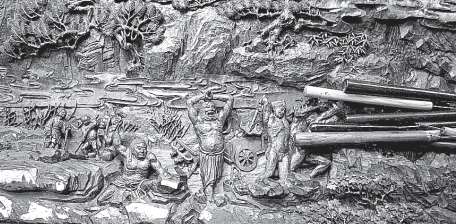 |
The large carving work, Yu Gong Yi Shan, by Hu Xianmin. [PHOTO BY GAO ERQIANG/CHINA DAILY] |
Hu Xianmin is in the midst of carving the scenes of a famous oil painting onto a piece of teakwood the length of a snooker cue.
The painting, titled Yu Gong Yi Shan, or "the foolish man who moved mountains", is based on a millennia-old Chinese fable of an old man who devoted his entire life to moving two mountains that prevented his family from accessing the outside world.
The 47-year-old wood carver could be said to share the same grit as the man in the painting. After all, the intricate craft of wood carving, which dates back to the Qin Dynasty (221-206 BC), is painstaking work. It took Hu one entire afternoon just to complete the facial expression of the man, which measured no larger than a matchbox.
"Just like stitching, wood carving requires great patience. You would also need to have the strength of a carpenter. We need to master these two aspects to be a good wood carver," said Hu.
An inheritor of the craft of Dongyang wood carving, which was in 2006 listed as a national intangible cultural heritage by the State Council, Hu is widely regarded as one of the best wood carvers in China. In a wood carving village built by the local government, he and a dozen other masters of the craft each have a museum displaying their wares.
While many of the craftsmen who have inherited intangible cultural heritages of China are facing the dilemma of being artistically recognized but financially challenged as there is little demand for their craft, wood carvers have in recent years been receiving too many orders to handle as the level of interest in the art form grows among wealthy Chinese.
Statistics from the local government show that the overall output of the wood carving industry in Dongyang, Zhejiang province, was 18 billion yuan ($2.86 billion) in 2016, up from 10 billion yuan in 2012. The number of craftsmen involved in the industry, not including those who have been relocated to other cities or countries, had also exceeded 30,000.
At the newly opened Shangri-La hotel in Yiwu, the city where Dongyang is located, a total of 594 pieces of wood carving are combined with the luxury hotel group's signature crystal chandeliers and floral painted wool carpets to reflect the local culture.
"I think it's in the genes of Chinese. There might be momentary interest or curiosity about Western-style villas or castles, but it's always the traditional Chinese pavilions and upturned-eaves on roofs that we find comfort in," said Hu, referring to the growing interest in wood carving.
The only son of a family that makes a living through farming, Hu became a wood carver immediately after he completed his mandatory education. While he was initially keen on becoming a painter, he eventually chose wood carving because he was told that it could provide a better livelihood. He later discovered that his painting skills allowed him to create more vivid creations on wood.
Today, Hu's studio is staffed by more than 30 people and 70 apprentices. Every year, they produce one to two large carving works that are typically taller than an average human. They also produce a score of smaller works that are usually used as decorations on beams and pillars of old houses that have been restored.
Hu noted that most of his clients are more interested in the quality and customization of his work than the price tag.
"In an era where everything can be 3-D printed, the value of hand-carved works would only be appreciated further," he said.